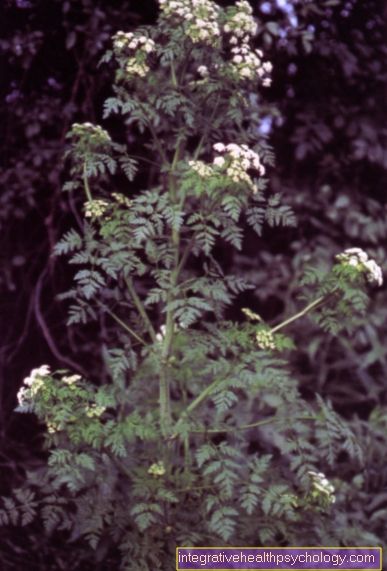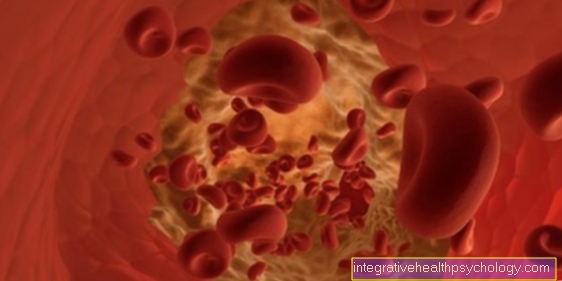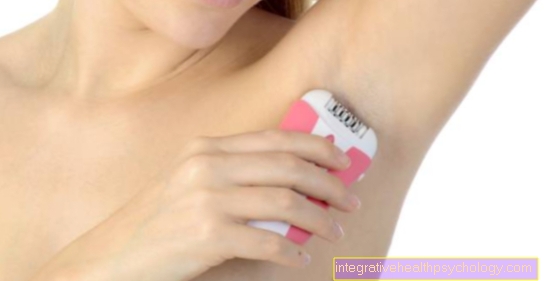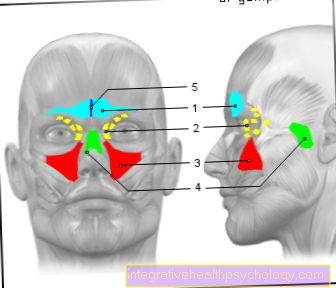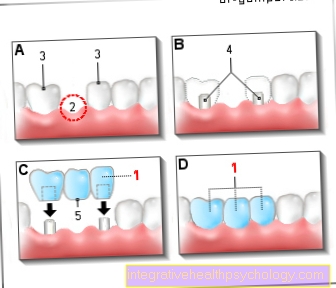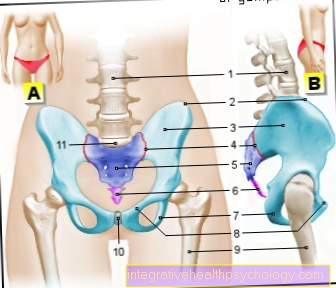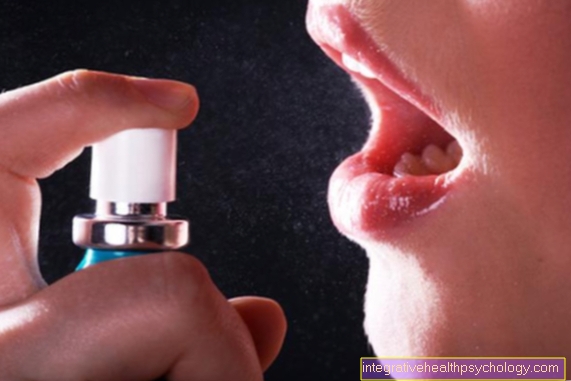Navel piercing
definition
The navel piercing is probably the most popular piercing and, as the name suggests, is stabbed in the navel.
There is the vertical as well as the horizontal stitch. However, the vertical variant is most popular with women.
The jump is only allowed from the age of 14 and only with the permission of the parents.
Only after the age of majority, i.e. not until the age of 18, can you be pricked without the permission of your parents.

Pricking a navel piercing
The navel piercing is always done lying down. The reason for this is that the abdominal wall is relaxed. Also, especially in younger patients, there are sometimes circulatory problems. If the patient actually faints, lying down is less dangerous, simply because the patient cannot injure himself if he falls over.
The skin in the navel, but also the skin around the navel, must be thoroughly disinfected, otherwise there is a risk of infection.
Care should also be taken to ensure that all instruments have been thoroughly sterilized.
Read more about the topic here: Belly button piercing is infected - what to do?
After disinfecting the skin, the entry and exit points should be marked. Then the skin is lifted up with a clamp and pierced with a needle. A piercing is then inserted directly into the resulting hole. The piercing should be made of hypoallergenic material, such as Surgical steel, insist to avoid an allergic reaction.
Please pay attention to the cleanliness of the piercing studio. Any piercing should be done either by a doctor or by a piercing studio you trust. You should never lend a hand yourself.
Can you prick a navel piercing yourself?
There are some women who plan to pierce their navel themselves. The cause is often the lack of parental permission, as piercers often refuse to pierce women who are too young without permission. Piercing yourself is also cheaper than having it done in a piercing studio. It is possible to get a navel piercing yourself. There are sets to buy that contain pliers, a needle, initial jewelry and disinfectant. Nevertheless, the dangers of piercing yourself are significantly greater than in a piercing studio. The risks of infection are excessively higher with self-piercing than with an experienced piercer. That's why you shouldn't prick a navel piercing yourself.
Pain when stabbing a navel piercing
When pricking a navel piercing, the disinfected skin on the navel is lifted with a clamp and then pierced with a needle. The navel piercing is inserted into the pierced hole. The first noticeable pain when stabbing the piercing is typically caused by the clamp, as it firmly clamps the skin to be pierced. It is important to find the correct position with the clamp in order to properly place the navel piercing. Depending on how much you move, holding the clamp can take different lengths of time. The prick with the needle through the skin is comparatively very quick and is described as a short, sharp pain. An ice spray can help reduce the pain when you sting. Everyone has a different sense of pain and perceives the pain when stabbing the piercing to different degrees.
Further information on the subject can be found here: Pain when stabbing a navel piercing
Navel piercing care
The pierced navel piercing is provided with a sterile plaster. At home, this must be changed regularly in the first few days; it is recommended twice a day. It also needs to be cleaned thoroughly with every change. Thorough hand washing is also necessary here.
First, the encrusted areas are removed with a clean cotton cloth or cotton ball and water. Then the piercing and the skin are treated with disinfectant spray to remove bacteria and germs.
This is extremely important in order to prevent infections / inflammations, which can otherwise end in the removal of the navel piercing or which can have worse consequences.
The navel piercing usually heals within about a month.
In order for it to heal quickly, the following should be observed in the first few weeks:
- Do not wear tight clothing around your stomach
- Don't go to the solarium
- Don't go to the swimming pool
- Don't take a bath, just shower
- Disinfect regularly
Please note that complete healing can sometimes take months.
New jewelry may only be worn after approx. 2 months.
Duration of healing
The navel piercing is a piercing that heals very laboriously, as the navel is exposed to a lot of movement, bending over, running, etc. and different clothing. The scar requires a lot of care and hygiene. Navel piercing takes about four to six months to heal. In the case of heavy stress, the healing time can take over a year. In the case of a newly pierced navel piercing, the jewelry may only be replaced after it has completely healed.
The cost of getting a navel piercing
The cost of having a navel piercing in a hygienic environment is on average between € 20 and € 60. Depending on the piercing studio, costs for the navel piercing may be added or included in the price. As a rule, there is a total price for the initial jewelry, the piercing and the care products for the first few days after the piercing.
Risks
A navel piercing should not be used on women / girls who are very thin. Because here there is a high tension in the abdominal wall and the pierced skin can heal poorly.
Pain is a common "side effect". However, every patient experiences pain differently and therefore no prediction can be made about the severity of the pain. Many piercing studios use cool packs to reduce the pain when stinging. Cold packs can also be used at home to cool after the lancing to reduce pain.
Other risks are the inflammation mentioned above. Poor hygiene can inflame the pricked skin. In the worst case, the bacteria can get into the bloodstream and cause blood poisoning. However, this is rather rare.
In the event of inflammation, a doctor should always be consulted.
Read more on the subject at: Inflammation of the belly button in adults, red spots around and above the belly button
In addition, swelling and redness can occur, which can usually be dealt with fairly quickly by cooling. Risks are also:
- Bruising
- easy bleeding and
- Scarring
If the navel piercing is not regularly moved into a different position, it threatens to grow in and can no longer be moved. Therefore, it must be ensured that the belly hub piercing is regularly brought into a different position.
You can read more about piercing at: Tongue piercing
How can you recognize inflammation on the navel piercing?
If the navel piercing becomes inflamed, this can often be recognized by the classic signs of inflammation: pain, reddening, warming, swelling and possible pus formation. This means that the skin around the navel piercing can look red. The skin area may be warmed up, and maybe even thickened and hardened. Inflammation often leads to pain, either only when pressure is applied to the piercing area or when it is touched. If the navel piercing is inflamed for a long time and has not been treated, pain often occurs even at rest. If the inflammation spreads, pus may develop. You may also experience itching around the navel area. If left untreated, it can develop into an abscess, i.e. a collection of pus in an encapsulated tissue space. If the inflammation is left untreated, the inflammation can spread to the blood. A fever often occurs. To avoid this, the inflammation at the navel piercing should be treated locally as early as possible.
Read more on the subject below: The navel piercing is infected - what to do?
How is inflammation on the navel piercing treated?
To prevent the inflammation from spreading to the belly button, the inflammation should be treated as early as possible. If there is a slight inflammation around the piercing area, you can first treat the inflammation yourself. This includes regular, careful cleaning and disinfection of the navel piercing. If the tissue around the piercing swells a lot, it can make sense to have a disinfected, longer piercing inserted. This will help reduce the bruising and tension on the inflamed skin. If the inflammation is more severe and pus or blood appears, a doctor should be consulted. In this case, it is often helpful to take an antibiotic ointment or antibiotic tablets.
Read more on the topic: My belly button is inflamed - what can I do?
Inflammation of the navel piercing during pregnancy
The inflammation of the navel piercing during pregnancy corresponds to the therapy of an inflammation of the navel piercing. This means that the piercing should be cleaned and disinfected if it is slightly inflamed. If the inflammation is worse, a doctor should examine the belly button and discuss appropriate therapy that is compatible with the pregnancy. Especially during pregnancy it is important to adapt the piercing length to the waist circumference and, if necessary, to use a longer piercing.
Belly button piercing itches - what can be behind it?
Itching around the navel piercing can have various causes. Inflammation is often the cause of the itching. Most of the time, the skin is also reddened, possibly warmed up and painful. Depending on the material of the navel piercing, an allergy can also be responsible for the itching. It is possible that there is an allergic reaction to the metal in the jewelry. In this case, a general practitioner or, better still, a dermatologist should take a look at the navel to be on the safe side. Another possibility for itching on the navel piercing is the wrong piercing length. There are navel piercings with lengths of 8, 10 and 12 millimeters. If the piercing is too long, it can be mechanically stressed by movement and clothing and chafe. This can initially itch and become red and in the worst case even become infected. Therefore, you should definitely choose a suitable piercing length and get thorough advice in the piercing studio. Similarly mechanically, wrong clothing can also lead to an itchy piercing. If you wear tailored, so-called "high waist" pants and a back, you put a lot of pressure on the piercing. Therefore, appropriate clothing and mesh tops should be avoided, especially with a freshly pierced piercing.
What to do if the navel piercing has grown out?
It can happen that a navel piercing grows out. A common reason for this is that the piercing was not pierced deep enough. Therefore, like all other piercings, navel piercings should only be pierced in professional piercing studios. The process of growing out can be seen when the skin over the navel piercing becomes thinner and thinner until the jewelry shows through. Depending on the person, anatomy and depth of the piercing, the piercing can grow out shortly after the piercing, only after years or at best never. If the navel piercing grows out, it should be removed. As a result, the original navel piercing hole will grow closed over time. How long it takes until the area is completely overgrown varies greatly between people and can take two to four months to years. If the skin area has healed well, you can have the navel piercing re-pierced if you want. It is important to have this done in a professional studio to prevent re-growth.
What should you watch out for if you have to re-pierce a navel piercing?
You can have a navel piercing re-pierced as soon as the previous piercing hole has healed completely. It doesn't matter whether a previous piercing grew out, whether you had to remove your navel piercing due to an operation, pregnancy or other reasons. It is important to ensure that the skin area is completely healed, otherwise stabbing the area again could cause severe wound healing difficulties. If you have a piercing re-pierced, it costs just as much as a new piercing. The pain when piercing through the tissue, possibly through scar tissue, can possibly be more severe than when piercing the first navel.
Navel piercing and umbilical hernia - is that possible?
If the navel is pointing outwards due to an umbilical hernia, the question arises for many women whether it is even possible to get a navel piercing. In principle, it is possible to get a navel piercing despite an umbilical hernia. There are exceptional cases in which the piercer advises against a navel piercing. Therefore it makes sense to get detailed advice from an experienced piercer beforehand as to whether a navel piercing makes sense and what the result may be. A navel piercing can even have the advantage of concealing the navel if the navel has grown out.






